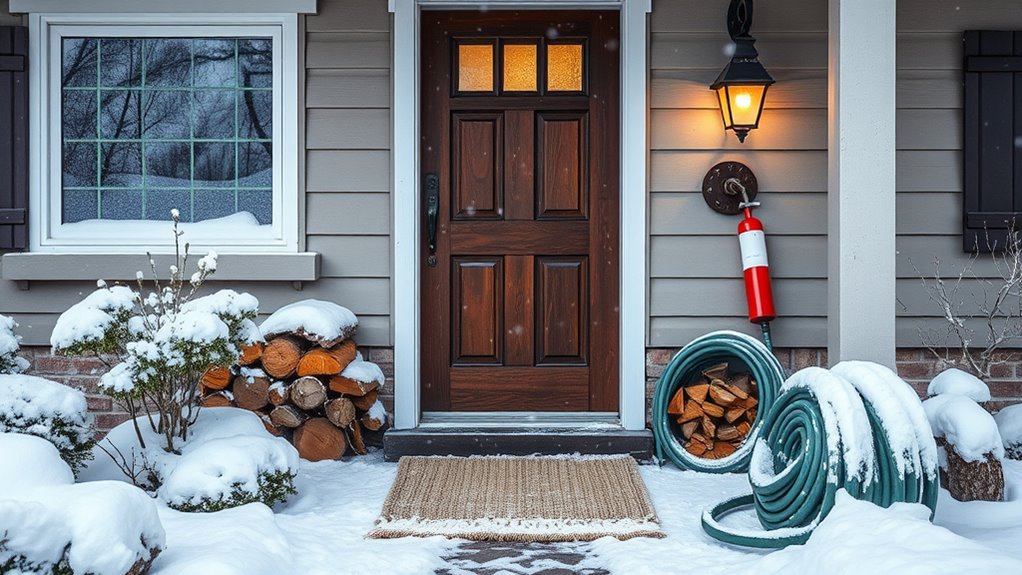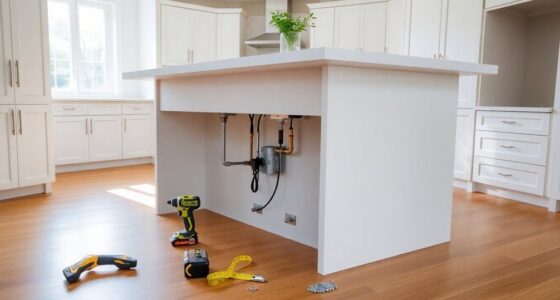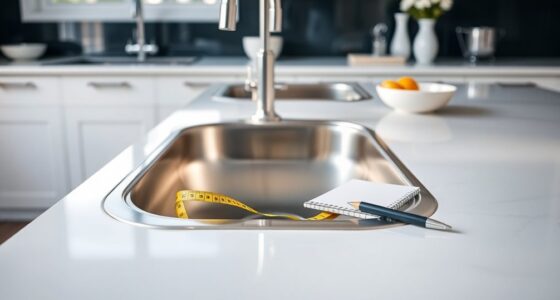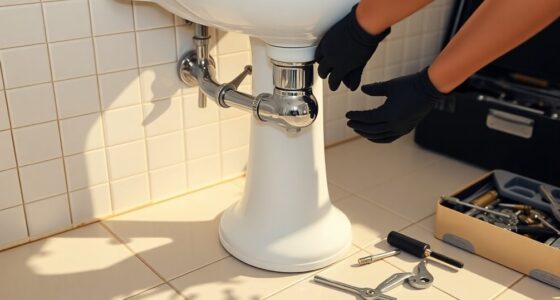To winterize your home, start by adding insulation to your attic, basement, and walls to keep warmth in and cold out. Seal gaps around windows and doors with weatherstripping or caulk to prevent drafts. Protect outdoor plumbing by draining hoses, disconnecting outdoor faucets, and insulating pipes. Consider installing a programmable thermostat to control heating efficiently. Taking these steps will help you stay warm and save money; continue to explore more tips to fully prepare your home for winter.
Key Takeaways
- Insulate attic, walls, and basements to retain heat and reduce energy costs.
- Seal gaps around windows, doors, and exterior walls with weatherstripping or caulk.
- Protect outdoor faucets and drain outdoor plumbing to prevent freezing and damage.
- Insulate exposed pipes in vulnerable areas like garages and crawl spaces.
- Maintain proper ventilation to control indoor humidity and prevent mold growth.

As winter approaches, preparing your home to withstand the colder months is essential. One of the most effective ways to do this is by making insulation upgrades. Proper insulation keeps warm air inside and cold air out, which means your heating system works less and your energy bills stay lower. Focus on areas like the attic, basement, and exterior walls, where heat loss is most common. Adding or improving insulation in these spots can greatly improve your home’s thermal efficiency. Don’t forget to check existing insulation for gaps or compression, which can reduce its effectiveness. Sealing these gaps with spray foam or weatherstripping helps prevent drafts and maintains consistent indoor temperatures. Upgrading insulation isn’t just about comfort; it’s also about protecting your home’s structure from moisture damage caused by condensation, which can be more prevalent during winter months. Additionally, ensuring proper ventilation helps manage indoor humidity levels and prevents issues like mold growth in the cold season.
Another essential aspect of winterizing your home is outdoor faucet protection. As temperatures drop, water remaining in outdoor faucets can freeze, expand, and cause pipes to crack or burst, leading to costly repairs. To prevent this, disconnect hoses and drain any remaining water from outdoor faucets. Installing faucet covers or foam insulators provides an extra layer of protection against the cold. These covers are simple to put on and remove, and they shield faucets from frost damage. If you have sprinkler systems or exterior pipes, drain them thoroughly or consider shutting off their water supply entirely. Sometimes, insulating pipes running along exterior walls or in unheated spaces like garages and crawl spaces is necessary to prevent freezing. Taking these steps ensures you won’t wake up to flooded basements or damaged plumbing when the first cold snap hits. Properly sealing and insulating exterior components also helps preserve the overall integrity of your home’s structure and prevents energy waste. Incorporating insulation materials that effectively resist moisture and temperature fluctuations further enhances your home’s winter resilience. Using moisture-resistant insulation can be particularly beneficial in areas prone to condensation or humidity issues. Additionally, choosing insulation with moisture-resistant properties can help prevent mold growth and water damage in vulnerable areas.
In addition to insulation upgrades and outdoor faucet protection, consider sealing gaps around windows and doors with weatherstripping or caulk. These small upgrades can stop drafts that make indoor heating less efficient, helping you save money and stay cozy. Check your home’s ventilation to prevent moisture buildup, which can lead to mold and damage in winter. If you have vents or exhaust fans, ensure they’re functioning properly and not blocked by snow or debris. Using energy-efficient solutions like programmable thermostats can also optimize your heating system’s performance and increase savings during the cold months.
Frequently Asked Questions
When Should I Start Winterizing My Home?
You should start winterizing your home during your seasonal maintenance routine, ideally in early fall before temperatures drop considerably. This timing helps maximize energy efficiency and ensures you’re prepared for cold weather. By addressing insulation, sealing leaks, and servicing heating systems early, you prevent costly repairs and keep your home warm and cozy all winter long. Don’t wait until it’s freezing outside—being proactive makes winter much more manageable.
How Can I Prevent Frozen Pipes in Winter?
To prevent frozen pipes, you should insulate your pipes with pipe insulation, especially in unheated areas. Keep your home warm, and let faucets drip slightly during cold nights to prevent pressure buildup. Open cabinet doors to allow warm air to reach pipes. These steps help avoid frozen pipes, which can burst and cause costly damage. Regularly check for leaks and keep the thermostat consistent to maintain warmth throughout your home.
What Are Cost-Effective Ways to Insulate My Home?
Your home’s insulation is your fortress against freezing temperatures, saving you heaps on energy bills. To keep costs low, opt for energy-efficient windows that seal out cold and consider DIY insulation methods like foam boards or weatherstripping. These simple, budget-friendly strategies dramatically boost warmth and comfort without breaking the bank, turning your home into an unbreakable shield against winter’s worst.
How Do I Check for Drafts Effectively?
To check for drafts effectively, start with air leak detection by feeling around windows, doors, and electrical outlets for cold spots. Use a lit candle or incense stick—if the flame flickers, there’s a leak. For a more thorough inspection, consider thermal imaging; it reveals hidden air leaks and insulation gaps. Address these issues promptly to keep your home warm and reduce energy costs during winter.
What Emergency Supplies Should I Have on Hand?
Back in the day, having an emergency kit was essential, and it still is. You should keep a well-stocked emergency kit with non-perishable food, water, batteries, and a flashlight. Don’t forget a first aid kit for minor injuries. Make sure you have warm blankets, extra clothing, and necessary medications. Being prepared guarantees you can handle power outages or storms safely, and you’ll have peace of mind knowing you’re ready for anything winter throws your way.
Conclusion
Now that you’ve taken steps to winterize your home, you’re all set to face the cold months ahead. Remember, a stitch in time saves nine — preparing now prevents bigger problems later. Stay proactive, keep your home warm and secure, and enjoy a cozy winter season. With these tips, you’ll keep the chill out and comfort in, making the season enjoyable rather than stressful. Stay warm and happy wintering!









